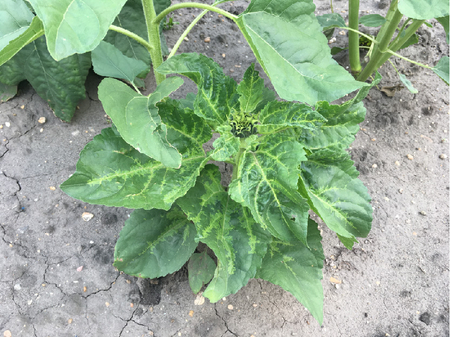Downy mildew of sunflower
Plasmopara halstedii
Profile
Downy mildew of sunflower is caused by the pathogen Plasmopara halstedii . Downy mildew fungi (Peronosporaceae) belong to the class of egg fungi, which are also known as oomycetes. Drippable water, such as dew, is essential for the life cycle of egg fungi. Plasmopara halstedii is listed as a Union regulated non-quarantine pest.
Damage symptoms
On young plants, irregular, light green to yellow brightenings develop along the leaf veins on the upper side. A white, felt-like coating (= sporangia carrier with sporangia) is formed on the underside of the leaf. Affected plants are retarded in growth and are compressed. The stem grows more slowly, is thus shortened and thickened, and the leaves are subsequently more densely packed together. In severe infestations, the leaves are curled. Under humid weather conditions, the white coating can also be formed on the upper side of the leaves. Early infestation often leads to the death of infected seedlings or young plants. If the pathogen attacks the plants in the flowering stage, it usually forms the white sporangial turf on both sides of the leaves on the highest-lying leaves.



Host plants
The main host plants are Helianthus annuus, Helianthus tuberosus, Xanthium strumarium, Artemisia dracunculus, Ambrosia artemisiifolia and Iva xanthifolia.
In addition, more than 100 species from the composite family (Asteraceae) are other host plants, including aster, goldmaria(Bidens), occupational herb (Erigeron), watercress (Eupatorium), coneflower (Rudbeckia), silphia (Silphium), and goldenrod(Solidago).
Propagation and transmission
Plasmopara halstedii is mainly seed-borne, but infected plant debris in the soil, susceptible weeds of the composite family (Asteraceae), and volunteer sunflowers also serve as sources of infection.
Downy mildew forms sporangial carriers with sporangia that release motile spores (zoospores). These zoospores require drippable water to travel and germinate. After germination, they penetrate directly into the plant tissue. After successful infection, the pathogen grows intercellularly and colonizes the host plant systemically. As the disease progresses, sporangia are formed again. The sporangia usually grow on the undersides of the leaves from the stomata or other openings in the plant. The sporangia are spread by wind or rain.
The pathogen survives by means of permanent spores and/or mycelium in the infected plant tissue of its host plants.
Phytosanitary status
Plasmopara halstedii is listed as a Union regulated non-quarantine pest and is transmitted through certain planting material. The presence of such pests leads to unacceptable economic consequences with regard to the intended marketing of the planting material. The import and movement within the EU are therefore uniformly regulated for specific seed and planting material.
Last updated: 25.05.2023
automatically translated